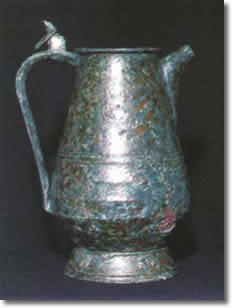In Site 2 an irregular rectangular structure (T) covered with a vault has been found. On this there lay a solid paving. It is a "dump", with an absorbent bottom perhaps, which was used as a waste-pit or rubblish dump (fig.2).
Two openings empty into this dump on the western and eastern sides for the draining of refluent water and solid refuse. Also, there is a narrow channel on the southern side sloping torwards the exterior, an "overfill" to facilitate the flow of liquids and avoid saturation. It was made by re-using Roman architectual material: sloping toward sthe outside, it carried the liuids away to the open area of the east, making use of an old surface of earthenware fragments.
The tufo-block walls, sometimes regular and at times rough-hewn, are unplastered and 18-20 centimentres thick. They make a kind of lining against earth, with no structural function in that the cement barrel-vaulted ceiling weigh on the Roman structures below. The height of the vault conditions that of the floor above, causing a staggering of height compared with the set-off of the large northern structure (N-O).
The rubbish dump, which seems to have been included in the external eastern fascia, is closely connected to the Angevin wall (P) to the west, to which one of the waste pipes is connected. The last unloadings of waste in the area, which is brim-full of earth, were probably made in the mid-15th century, during the building of the new castle. It was at that time that a cut was madein the vaulted roof and the floor above. Although it has not been possible to establish a clear stratigraphy, the finding of 15th-century potteryin the upper levels of the dump is to be attributed to the last use of the structure. The filling, which is characterised by the presence of widespread ash, has brought down to us fine dining-hall and kitchen pottery, containers covered inside with fish scales, iron utensils for artisan use, pieces of locks and doors, a horseshoe, a short sword, personal objects of ornamentation, a considerable quantity of nails and a great many animal bones.
Overall, the archeological material in the dump is from the period between the end of the 13th and the first half of the 15th century. The findings lead us to think that the dump was related to service-areas of the Angevin castle, both those relating to kitchens and those to do with artisan work.



